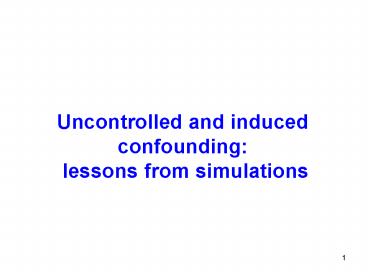Uncontrolled and induced confounding: lessons from simulations - PowerPoint PPT Presentation
1 / 19
Title:
Uncontrolled and induced confounding: lessons from simulations
Description:
bias increases with var(Mat CRP) bias decreases with var(Mat SBP) 18. A special example: ... Maternal CRP (mg/L) Instrumental variables ... – PowerPoint PPT presentation
Number of Views:78
Avg rating:3.0/5.0
Title: Uncontrolled and induced confounding: lessons from simulations
1
Uncontrolled and induced confounding lessons
from simulations
2
Contents
- Simulations of the 5-variables setting
- Investigating the direction and extent of the
bias - A special case the instrumental variables
approach
3
The setting determinants of SBP
Maternal education (years)
Maternal CRP (mg/L)
Maternal SBP (mmHg)
SBP (mmHg)
Birth weight (kg)
- To run the simulations
- -generate each variable in sequence
- Each with independent normally distributed errors
- Relations defined by regression coefficients
corresponding to the arrows
4
N(2,1)
Maternal CRP (mg/L)
Maternal education (years)
N(8,2)
5
N(2,1)
Maternal CRP (mg/L)
Maternal education (years)
N(8,2)
1
-2
Maternal SBP (mmHg)
N(100,5.8)
Mat_SBP 100 1 Mat_CRP 2 Mat_Educ e
eN(0,4)
Var(Mat_SBP) 11 44 16 33 and
sd(Mat_SBP)5.8
6
N(2,1)
Maternal CRP (mg/L)
Maternal education (years)
N(8,2)
1
-2
Maternal SBP (mmHg)
N(100,5.8)
0.2
-0.05
Birth weight (kg)
N(3.5, 0.7)
7
N(2,1)
Maternal CRP (mg/L)
Maternal education (years)
N(8,2)
1
-2
0.25
Maternal SBP (mmHg)
N(100,5.8)
0.2
-0.05
0.02
-2
SBP (mmHg)
Birth weight (kg)
N(3.5, 0.7)
N(90,4.3)
5 models fitted to estimate the effect of birth
weight on SBP - crude - adjusted for Mat
SBP - adjusted for Mat SBP Mat_CRP -
adjusted for Mat SBP Mat_educ - adjusted for
all three
8
Estimates of the effect of birth weight (true
value is -2)
After 10,000 simulations
Sample size 100
9
Estimates of the effect of birth weight (true
value is -2)
After 10,000 simulations
Sample size 1000
-ve bias
ve bias
10
What determines the magnitude and direction of
the bias?
- the backdoor paths.
- Consider
- A- omitted confounders crude estimate
- B- wrong confounder controlled for Mat_SBP
11
A- Omitted confounder
TRUE MODEL x3 ß31 x1 ß32 x2 e3
Bias
FITTED MODEL x3 ß31 x1 e3
12
A- Omitted confounder
x2
ß12
ß32
X3
X1
ß31
Bias -increases with the variance of X2 and
conditional variance of X3 -increases with the
correlations along the indirect paths -its
direction is determined by the signs of these
correlations
13
In a more complex setting
ß32
ß31
ß42
ß51
ß43
ß53
ß54
Crude estimate based on x5 ß54 x4 e5
Bias is affected as before by signs of the
correlations / regression coefficients, and the
variances along the indirect paths
14
-
ß32
ß31
ß42
?51
-
ß43
ß53
ß54
In our example, bias depends on ß34
ß53 ß24 ß32 ß53
ß24 ß32 ß51 ß14 ß51
- sum of biases is negative
- crude estimate lt ß54
15
B- wrong confounder
X2
X1
?12
X3
X5
X4
Controlling for X3 induces a correlation between
X1 and X2
- It turns out that ?12
- has the opposite sign of (ß32 ß13 )
- increases with var(X134) and var(X214)
- but decreases with var(X34) and var(X4)
- In our example
- ?12 is positive
- adj estimate gt ß54
16
When ß32 (Mat Educ to mat SBP) is negative
bias increases with var(Mat CRP) bias
decreases with var(Mat SBP)
ß543
Increasing Var(Mat_CRP)
True value
Increasing Var(Mat SBP)
17
When ß32 (Mat Educ to mat SBP) is positive
bias increases with var(Mat CRP) bias
decreases with var(Mat SBP)
True value
ß543
Increasing Var(Mat_CRP)
Increasing Var(Mat SBP)
18
A special example the IV approach
19
Instrumental variables
What if this is not zero?
Maternal CRP (mg/L)
Maternal SBP (mmHg)
2
ß53
SBP (mmHg)
U
ß53
If U is unmeasured, we can obtain unbiased
estimates of using the regression of SBP on Mat
CRP and of SBP on Mat CRP
20
True value
IV estimate
Increasing strength of the instrument
Regression coefficient relating the instrument
with the unmeasured confounder































